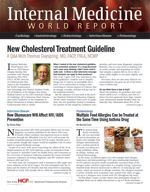Publication
Article
Internal Medicine World Report
More on Catheter Ablation As First-line Therapy for Atrial Fibrillation
Author(s):
Study finds a lower rate of recurrent atrial tachyarrhythmias among patients with paroxysmal atrial fibrillation who underwent radiofrequency catheter ablation as a first-line treatment rather than taking antiarrhythmic drugs.

A study published in The Journal of the American Medical Association found a lower rate of recurrent atrial tachyarrhythmias among patients with paroxysmal atrial fibrillation (AF) who underwent radiofrequency ablation as a first-line treatment rather than taking antiarrhythmic drugs.
Still, the study noted, recurrence was common in both groups after 2 years, quality of life improvements were comparable, and the ablation group was more likely to suffer severe complications such as cardiac tamponade.
Researchers at 16 medical centers in North America and Europe divided up 127 young, treatment-naïve patients, randomly selecting 61 for treatment with antiarrhythmic drugs and 66 others for radiofrequency ablation.
After 2 years of monitoring, 44 patients (72.1%) in the antiarrhythmic group and 36 patients (54.5%) in the ablation group were documented to experience at least one incidence of symptomatic or asymptomatic AF that lasted more than 30 seconds (hazard ratio [HR], 0.56 [95% CI, 0.35-0.90]; P = .02).
Looking specifically at symptomatic AF, that was observed in 59% of the drug group and 47% of the ablation group within 24 months (HR, 0.56 [95% CI, 0.33-0.95]; P = .03).
Both groups reported moderately impaired quality of life at baseline, and both groups reported statistically equivalent improvement at the 1-year follow-up.
No deaths or strokes were reported in either group, but there were 4 cases of cardiac tamponade reported in the ablation group, along with a severe pulmonary vein stenosis and a bradycardia that required the placement of a permanent pacemaker. The study’s authors specifically noted that ablation carries serious risks that “need to be discussed with the patient” before it is offered as a first-line therapy.
The complications observed in the antiarrhythmic drug group were less common: atrial flutter with 1:1 conduction (1 patient) and syncope (2 patients).
Still, 26 patients who began receiving the antiarrhythmic drugs (43%) opted to undergo an ablation after 1 year.
The Radiofrequency Ablation vs Antiarrhythmic Drugs as First-Line Therapy of Atrial Fibrillation 2 (RAAFT-2) trial comes nine years after a smaller, shorter RAAFT-1 trial on 70 patients found AF recurrence rates of 63% in its antiarrhythmic drug group vs 13% in its catheter ablation group at 12 months’ follow-up.
More recently, a larger trial dubbed Medical Antiarrhythmic Treatment or Radiofrequency Ablation in Paroxysmal Atrial Fibrillation (MANTRA-PAF) found no difference in cumulative AF burden among 294 patients randomized between medication and ablation and followed for 2 years.
An editorial that accompanied publication of the RAAFT-2 results in JAMA said the new trial was a valuable addition to those earlier trials, offering further evidence not only that ablation is nothing like the AF cure it was once hoped to be but also that there is little difference in the performance of medication and ablation as a first-line treatment strategy.
The editorial further noted that the results of this study seem to affirm existing consensus guidelines on AF ablation: “class 1 level of evidence A” for patients who have failed on at least 1 medication but only “class 2 level of evidence B” for those who have not failed on medication.






